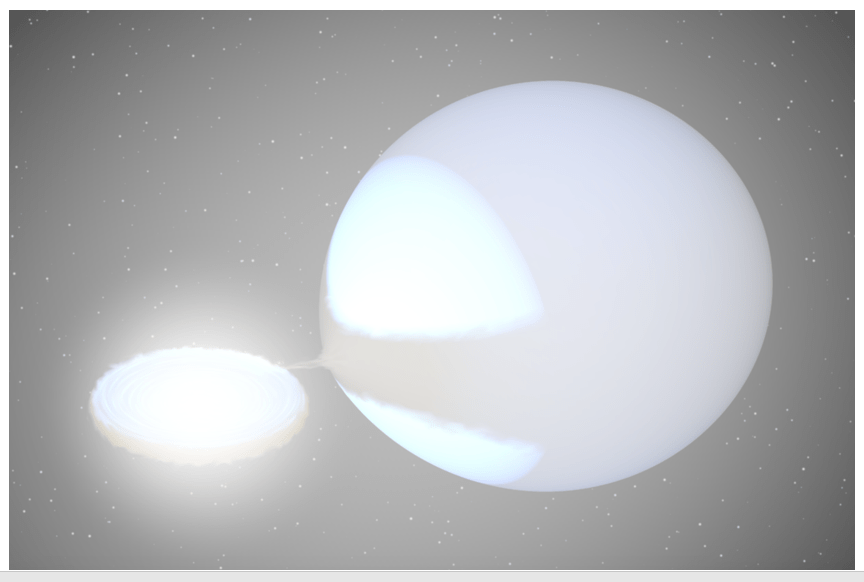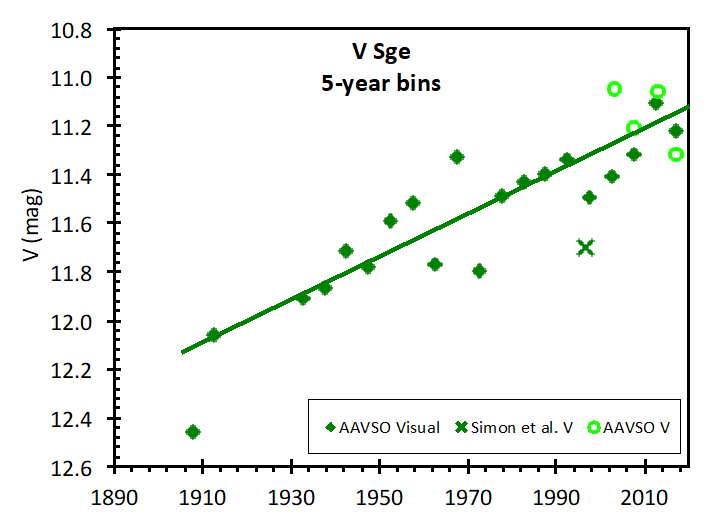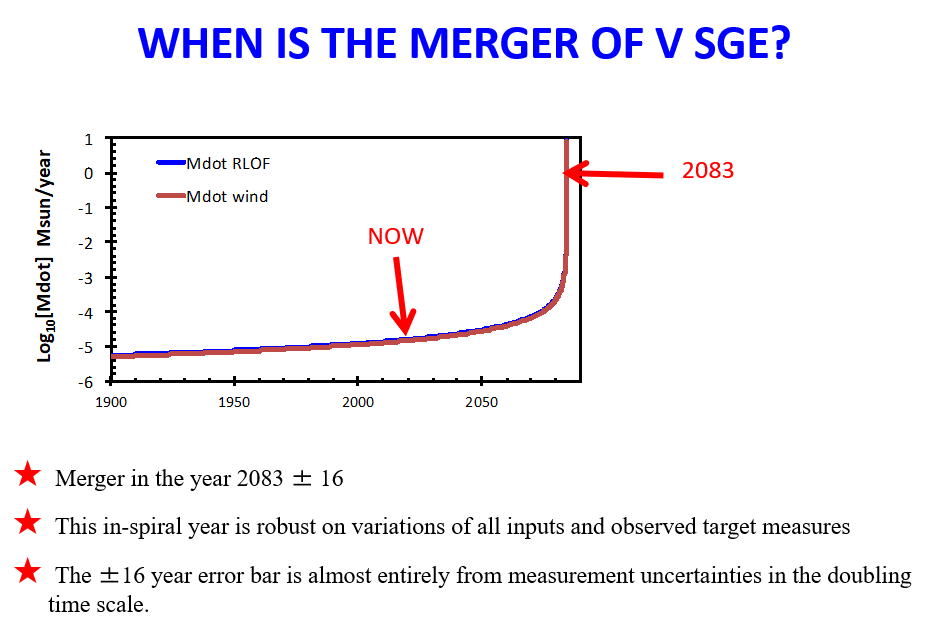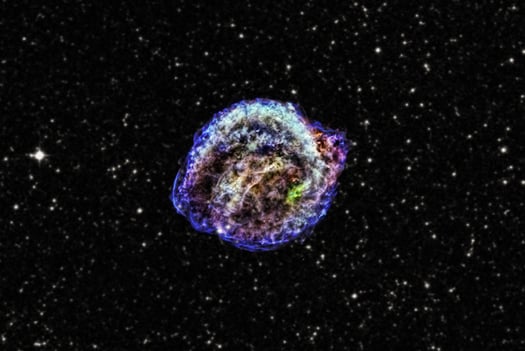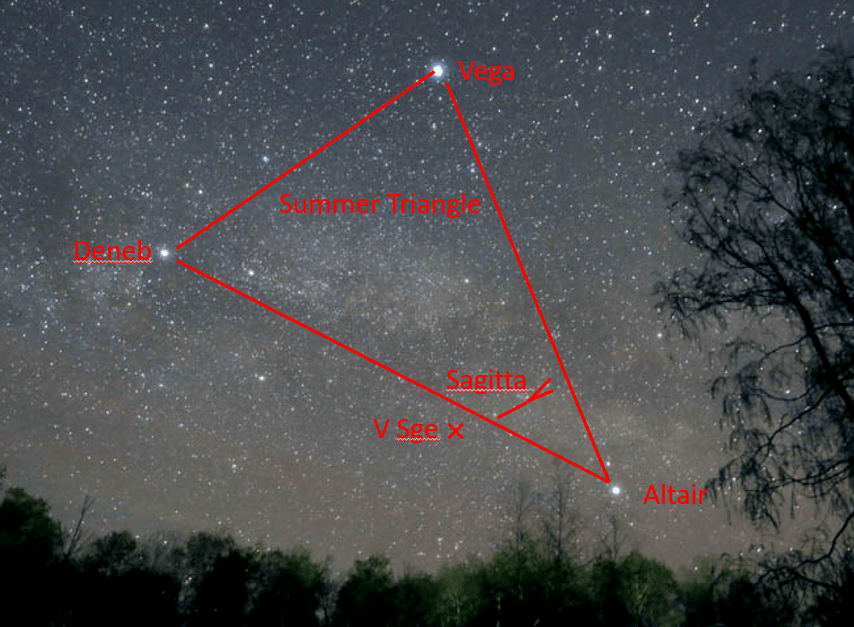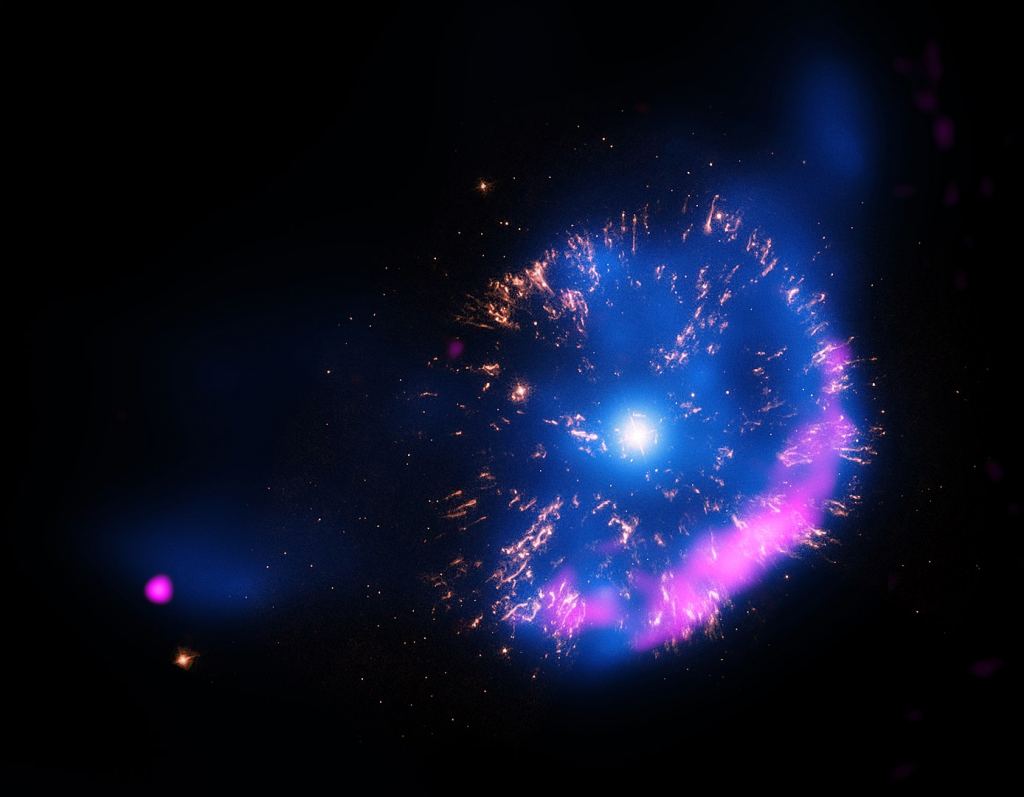The star V Sagittae is the next candidate to explode in stellar pyrotechnics, and a team of astronomers set the year for that cataclysmic explosion at 2083, or thereabouts. V Sagittae is in the constellation Sagitta (latin for arrow,) a dim and barely discernible constellation in the northern sky. V Sagittae is about 1100 light years from Earth.
In 1902 astronomers discovered V Sge as a variable star, and in 1963 a team of astronomers led by American George Herbig identified it as a binary star. It's in a class of stars called cataclysmic variables (CVs), where an ordinary star orbits a white dwarf. The orbiting star is the primary star, and the secondary star is a mass transferring star.
In a cataclysmic variable, the two stars are close enough together that the white dwarf's gravity distorts the secondary star. Material from the secondary star, or donor star, is drawn into an accretion ring around the white dwarf. The material in the accretion disk emits strong UV and X-ray energy as it falls into the white dwarf.
"In all other known CVs the white dwarf is more massive than the orbiting normal star, so V Sge is utterly unique." Professor Emeritus Bradley E. Schaefer, LSU Department of Physics & Astronomy; Lead Author
According to new research, the V Sge stars are in a death spiral. Over the next few decades, V Sge will brighten dramatically. Then, sometime near 2083, it'll reach a tipping point. There'll be so much mass transfer from the donor star to the white dwarf that the donor star will spiral closer until they merge. That inevitable merger will cause a catastrophic nova.
Professor Emeritus Bradley E. Schaefer, LSU Department of Physics & Astronomy, led the new study.
"We now have a strong prediction for the future of V Sge," said Professor Schaefer in a press release. "Over the next few decades, the star will brighten rapidly. Around the year 2083, its accretion rate will rise catastrophically, spilling mass at incredibly high rates onto the white dwarf, with this material blazing away. In the final days of this death-spiral, all of the mass from the companion star will fall onto the white dwarf, creating a super-massive wind from the merging star, appearing as bright as Sirius, possibly even as bright as Venus."
The new research was presented at the American Astronomical Society's Annual Meeting.
Cataclysmic variables are a large diverse category of stars with many different types. V Sge is among the most extreme type. In V Sge's case, the donor star is almost four times as massive as its white dwarf companion, making it the only known CV where the donor star is more massive than the dwarf.
V Sge is about 100 times more luminous than any of the other known CVs. The pair is powering an enormously powerful stellar wind, and this sets up a spectacular end to the binary system. The extreme luminosity means only one thing: the white dwarf is stripping more and more material from the donor star. Some of that material will accrete onto the white dwarf and some is accelerated into space away from the white dwarf in a fierce solar wind, clouding the system. Eventually the donor star will lose so much material that it's orbit will decay and the two will collide.
"In all other known CVs the white dwarf is more massive than the orbiting normal star, so V Sge is utterly unique," said Schaefer.
Astronomers have known for a long time that V Sge was an unusual binary with strange properties. But only now have they understood that the pair were in a tightening death spiral. That's because there are archived photos of V Sge going back to the 1890s that show the star brightening over time as the white dwarf accretes more and more material from the donor.
"Previously, astronomers have studied V Sge, realizing that it is an unusual system with extreme properties," said Juhan Frank, a member of the team. "However, no one had realized that the binary orbit was in-spiraling very fast."
V Sge is experiencing extreme brightening by a factor of 10x and 2.5 magnitudes since about 1907, according to the archive of images from the American Association of Variable Star Observers.
"V Sge is exponentially gaining luminosity with a doubling time scale of 89 years," said Frank. "This brightening can only result with the rate of mass falling off the normal companion star increasing exponentially, ultimately because the binary orbit is in-spiraling rapidly."
"In anticipation of this fast decaying of the orbit, the fate of V Sge is sealed," stated Schaefer. "The critical and simple physics are derived from V Sge having the companion star being much more massive than the white dwarf star, so forcing the rate of mass transfer to rise exponentially. Anticipating the next few decades, V Sge will in-spiral at a rapid pace with increasing brightness."
"Inevitably, this in-spiral will climax with the majority of the gas in the normal star falling onto the white dwarf, all within the final weeks and days," Schaefer said. "This falling mass will release a tremendous amount of gravitational potential energy, driving a stellar wind as never before seen, and raise the system luminosity to just short of that of supernovae at peak."
With all of the historical data, the team was able to calculate when V Sge will collide together.
"From this critical new input of the doubling time scale of 89 years, it becomes possible to directly calculate the future evolution of V Sge, all using standard equations describing the many physical mechanisms involved," said Schaefer.
The calculations show that the cataclysmic collision will happen in 2083 +/- 16 years.
"The uncertainty in this date is ±16 years, arising mostly from not having a perfect measure of the doubling time scale due to the large intrinsic jitter of the brightness in the historical record," said Frank. "Therefore, the merge will be approximately between 2067 and 2099, most likely near the middle of this range."
The peak brightness will last about a month and it will be in between Venus and Sirius in that respect. Once the two stars have merged, the donor star will be gone and only a single red giant star will remain. That star will have a core of degenerate electron matter, consisting of electrons forced into the lowest energy state by the overlying material. The overlying material in this case will be a hydrogen burning layer surrounded by a vast halo of mostly hydrogen.
When the merger and the brightening happen, it will be historic. The V Sge event won't be as bright as the famous Kepler Supernova of 1604. Kepler's Supernova was visible in the day time sky for about three weeks, and it was recorded by several civilizations around the world at the time. But V Sge will also be visible with the naked eye.
"Thus, V Sge will appear startlingly bright in the night sky," said Schaefer. "This is substantially brighter than the all-time brightest known nova (at -0.5) just over a century ago, and the last time any 'guest star' appeared brighter was Kepler's Supernova in the year 1604."
"Now people the world over can know that they will see a wondrous guest star shining as the brightest in the sky for a month or so, being pointed at by the Arrow just below Cygnus, the Swan," said Schaefer.
The novas created by this type of merger are used as standard candles in astronomy, allowing astronomers to measure huge distances. Some novas also leave remnants behind, though they're not as energetic or massive as supernova remnants. Nova remnants can last for a few centuries.
More:
- Press Release: Binary Star V Sagittae to Explode as very Bright ‘Nova’ by Century’s End
- Supporting Information: https://www.lsu.edu/physics/v_sagittae.php
- Universe Today: This Star Has Been Going Nova Every Year, for Millions of Years
 Universe Today
Universe Today

